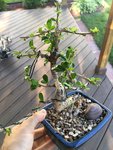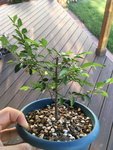DrTolhur
Mame
A lot of videos I see about training and pruning bonsai trees shows fairly large trees with lots of extra branches and growth. It seems like there's always lots of cutting going on. But as I look at my young bonsais, there's just not all that extra stuff that needs to be removed. So I'm wondering how one decides whether to just let a young tree grow (largely) unchecked for a while until it gets crazy before doing any branch removal or keeping an eye on new growth and constantly removing things you don't want, keeping branches shorter, etc. Hopefully that makes sense.
For instance, I have a Fukien tea that is not all that big, but the branches it has are pretty well hardened off. I'm not sure how many I'll be keeping, but it seems better in this instance to let it grow for a while and develop some fresh growth and foliage before I do much to it. However, in the case of a small Chinese elm (I assume it's a cutting), it has lots of branches that I know will end up being either cut back hard or off altogether. For this one, I'm less certain of which route to take. I'm currently thinking the same thing here -- just letting it get some size for a while -- but if I know I don't want some branches (and they're not sacrificial), why let the tree keep putting energy there? Why not keep it focused on growing where I want starting now?
I've attached a couple of pictures just for reference of what I'm talking about, but my question is more asking about in general, how one determines to allow longer-term growth vs. keeping growth focused and intentional. Comments either generally or about these trees are welcome. Thanks.


For instance, I have a Fukien tea that is not all that big, but the branches it has are pretty well hardened off. I'm not sure how many I'll be keeping, but it seems better in this instance to let it grow for a while and develop some fresh growth and foliage before I do much to it. However, in the case of a small Chinese elm (I assume it's a cutting), it has lots of branches that I know will end up being either cut back hard or off altogether. For this one, I'm less certain of which route to take. I'm currently thinking the same thing here -- just letting it get some size for a while -- but if I know I don't want some branches (and they're not sacrificial), why let the tree keep putting energy there? Why not keep it focused on growing where I want starting now?
I've attached a couple of pictures just for reference of what I'm talking about, but my question is more asking about in general, how one determines to allow longer-term growth vs. keeping growth focused and intentional. Comments either generally or about these trees are welcome. Thanks.






